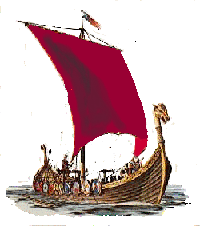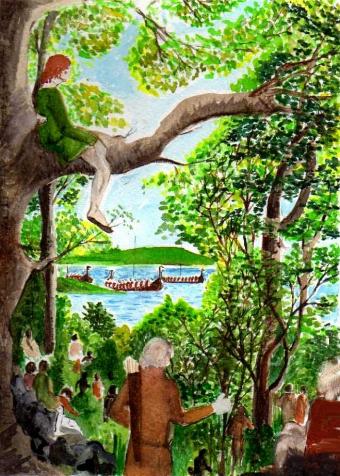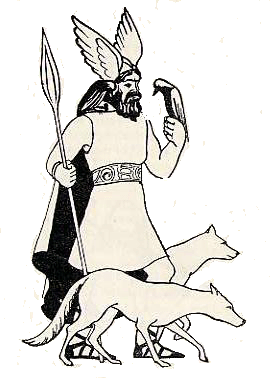| |
The Vikings in Ireland.Irish History(795-950) |
|
| |
Read
about The Vikings From 'A
Concise History of Ireland' by P
W Joyce |
||||
The fact is that Ireland had its own naval fleets, the Ulaid of Ulster were in possession of war galleys some four hundred years earlier, when after the Roman withdrawal from Britain they began raiding the western seaboard of that country, in fact St. Patrick was probably captured in one of these raids. The fact that Ulster has no identifiable long term Viking settlements, save for a burial in Ballyhome bay near Bangor in County Down, would indicate that the Ulaid while failing to protect the monasteries from occasional raids, did hold overall control of the land. Ulster was not the only provence with defensive capability's, in 796 a Viking chief called Thorgestr brought a fleet up the river Shannon into Lough Ree. King Malachy attacked the invaders and after a conflict which lasted three months half of Thorgestr's fleet were sunk, Thorgestr was captured and drowned in Lough Owel by Malachy. The Vikings first over wintered, at the mouth of the River Liffey, in 841-842 this is considered as the date of the founding of Dublin city. At this time in history and for a long time after Ireland was a country of fragmented kingdoms, vying with each other for supremacy. The Irish failed to drive the Vikings from Ireland, around 914 new waves of invasions began, by now the Irish were in a better position to defend themselves, perhaps they had increased their naval force and learned the Vikings battle tactics. Whatever the case in 926 we see the Vikings being
defeated in a sea battle on Strangford
Lough (Co Down) by Muirchertach, son of Niall Glendubh, in that year
the annals report that he beheaded 200 Vikings in Carlingford
(County Louth). Muirchertach known as The Irish counter attacked with increasing success, and in 944 the kings of Tara and Leinster sacked Dublin. By this time, the Vikings had settlements at Wexford, Waterford, Cork, and Limerick, as well as Dublin. These were the first towns in Ireland, and the Vikings who lived in them began to develop trade. They also married into Irish families and, eventually, became Christian. Viking leaders became like other rulers in Ireland and often hired themselves as mercenaries in the wars between rival Irish kings. |
||||
|
|
|
|

 in 793
at Lindisfarne Island on the coast of Northumbria in England and
in Ireland in 795, when they plundered the monastery on Lambay Island,
off the Dublin coast. At first, they came in small parties, made
surprise attacks on places along the coast, and sailed away with
their plunder. But, after about 830, the Vikings changed their tactics.
in 793
at Lindisfarne Island on the coast of Northumbria in England and
in Ireland in 795, when they plundered the monastery on Lambay Island,
off the Dublin coast. At first, they came in small parties, made
surprise attacks on places along the coast, and sailed away with
their plunder. But, after about 830, the Vikings changed their tactics.
 were
the main target of the Vikings, although the monks had other raiders
to contend with, their Irish neighbours. According to historian
Donncha O'Corrain in the first quarter of the ninth century the
Vikings committed twenty six recorded acts of violence against some
eighty seven by the Irish themselves.
were
the main target of the Vikings, although the monks had other raiders
to contend with, their Irish neighbours. According to historian
Donncha O'Corrain in the first quarter of the ninth century the
Vikings committed twenty six recorded acts of violence against some
eighty seven by the Irish themselves. Muirchertach
of the Leathercloaks, must have been the scourge of the Vikings, he defeated
them on many occasions not only in Ireland but on the west coast of Scotland,
up until his death at the battle of Ardee County Louth in 943. See
Muirchertach
of the Leathercloaks, must have been the scourge of the Vikings, he defeated
them on many occasions not only in Ireland but on the west coast of Scotland,
up until his death at the battle of Ardee County Louth in 943. See